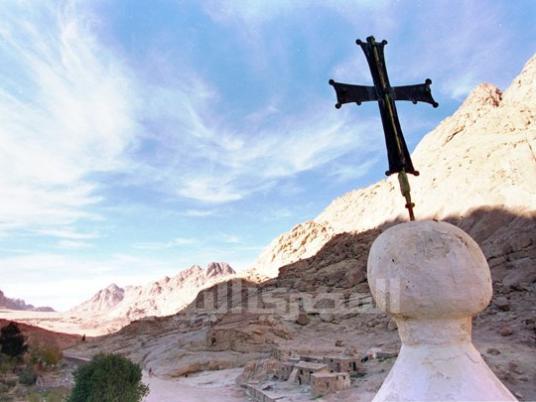
Visitors to the “Lost Gods” exhibition, currently showing at Darb 1718, are asked to dig through leather baskets of coarse salt and extract small sculptures and artifacts from the past. Then they place their findings on an adjacent shelf, in the order that they see fit, to create a storyline or vision of history.
The purpose of “Lost Gods,” according to the award-winning American artist Joshua Goode, is to question how history is written and how historical narratives gain their relative importance. Raising these questions in Egypt now was particularly important to him.
At first sight, the sculptures seem like valuable, gold artifacts — figurines of mythological creatures. However, closer examination reveals them to be plastic toys — like the green soldiers children play with — that have merely been sprayed gold. Many of the items have also been cut and melted onto one another to create surreal creatures.
For example, the two pieces I unearthed were a dolphin’s head attached to the lower half of a male body, and the legs of what looks like a character from ancient Egypt. After placing these findings on the shelf, and looking at the other 50 or so [out of 200 total] sculptures currently sitting there, “Lost Gods” seemed to promise quite little.
The whole experience takes only a couple of minutes, unless one is keen to personally unearth every item, which was tempting. But then, between the mix and match of disfigured dinosaurs, hunters, and characters from already-established ancient civilizations on the shelf, there seemed little to be gathered in terms of a revealing narrative, unless the narrative speaks of a history when humans and animals used to crossbreed. Perhaps, because the toys that Goode uses in the exhibit, like items from ancient Egypt and dinosaur figurines, already have such a strong historical narrative associated with them, it is difficult to see beyond that.
So, whereas the concept of the exhibit is itself fascinating, “Lost Gods” comes off as quite anti-climactic, as each visitor pulls out one or two gilded plastic toys, puts them on the shelf, and walks away with little to think about beyond the basic notion that history is rarely objective. It certainly would have been more interesting if there was actually some hint of a narrative or culture to be discovered in the salt baskets, one that visitors could then spend hours trying to piece together and figure out, searching for more clues and engaging in conversations, which would possibly entice them to return to the exhibit later.
However, it could be that Goode was trying to be playful, using disfigured plastic figurines to portray a certain randomness and imprudence in trying to dig up and narrate the past. Perhaps using handcrafted sculptures rather than mass-produced toys might have been more effective in achieving Goode’s vision — as novelty and self-exploration, important parts of digging up the past in real life, seem to be missing elements in “Lost Gods.”
That being said, “Lost Gods” is still worth visiting as the experience of digging through raw salt in leather baskets and unearthing golden items is, in a way, enjoyable in itself. Also, some of the figurines do look quite interesting, such as the golden horse whose head is replaced by three snakes. Overall, visitors are initially intrigued by the figurines, but ultimately left unfulfilled.
“Lost Gods” is on display until 20 August at Darb 1718, Kasr El Sham St., Al-Fakhareen, Old Cairo, Cairo.





